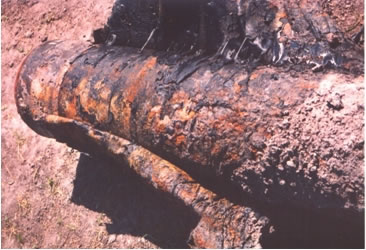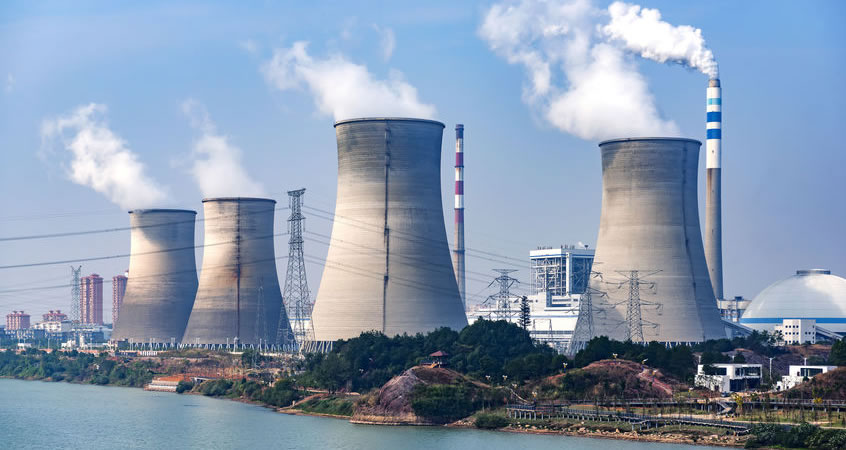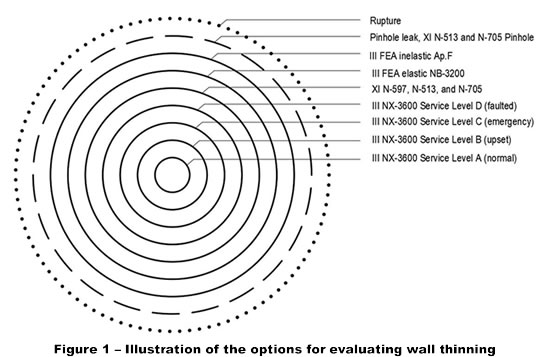Tornado Design For Nuclear Power Plants: A Brief History

Nuclear power plants are designed to be capable of a safe shut-down in case of a large design-basis tornado or hurricane. The magnitude of the postulated design-basis tornado or hurricane is such that there is less than 1 in 10 million chance (1E-7) per year and per reactor that it would be exceeded. This probability governs the wind speeds, pressures, and missiles generated by the tornado and provide the engineers a basis for design of the plant structures, systems, and components.
This paper consists of two parts. First, Part 1, is a quick overview of the NRC regulations which govern tornado and hurricane design for nuclear power plants. Part 2 is a timeline of key developments in tornado design for nuclear power plants over the last 70 years. For it is important that engineers understand not only what they are to do, but also why and how we got where we are.
PART 1 – Roadmap to Regulatory Requirements
General Design Criteria – The protection of nuclear power plants for the effects of tornadoes (or extreme winds from typhoons or hurricanes, depending on the locality) is required through 10CFR50 Appendix A, General Design Criterion 2 which requires that structures, systems, and components (SSCs) important to safety be designed to withstand the effects of natural phenomena such as tornadoes.
Standard Review Plan – The methods and criteria for the design of SSCs against the effects of tornadoes are addressed in the following Sections of NUREG-0800 (Standard Review Plan):
Section 2.3.1 addresses regional climatology. This Section refers to RG 1.76 for the postulated design-basis tornado parameters.
Section 3.3.2 addresses tornado loadings. This Section defines the three effects to be addressed:
- Tornado winds, considering translational and rotational wind speeds.
- Tornado-generated atmospheric pressure differentials across the interior and exterior of enclosed or partially-enclosed structures.
- Tornado missile impacts on exposed SSCs.
Regarding design rules, Section 3.3.2 refers to:
- ASCE-7 for calculating the wind pressure on SSCs.
- RG 1.76 and the textbook by Simiu and Scanlan for differential pressure loads.
- RG 1.76 and Section 3.5.3 for tornado missiles.
Section 3.5.1.4 addresses missiles generated by tornadoes and extreme winds. This Section refers to RG 1.76 for tornado missiles and to RG 1.221 for hurricane missiles.
Section 3.5.2 provides guidance to identify the SSCs that must be protected from externally-generated missiles.
Section 3.5.3 addresses the barrier design procedures. This Section points out the need to address local effects and overall response (global effects):
Local Effects
Local effects on concrete include penetration (crater) or perforation (full penetration), spalling (at the impact face) and scabbing (at the opposite face). This Section refers to the 1976 paper by R.P. Kennedy, the National Defense Research Committee (NDRC) formula, and it provides a Table of minimum concrete wall and roof thicknesses, by Tornado Region.
Local effects on steel include penetration (crater) or perforation (full penetration). This Section refers to the 1959 Stanford Research Institute (SRI) empirical formula (Zabel et. al., ORNL TID-4500, 1965), and the 1971 Ballistic Research Laboratory (BRL) empirical formula (Grabarek, BRL-MR-2134) if it leads to results comparable to SRI.
Global Effects
For global effects on concrete or steel, this Section refers to the 1973 paper by Williamson and Alvy, with ductility capacities from N-690-1994 with 2004 supplement.
Regulatory Guide – RG 1.76 provides three key design inputs: The tornado wind speeds, the differential atmospheric pressures, and the characteristics of tornado missiles.
RG 1.76 Tornado Wind Speed and Pressure Drop: The tornado intensity regions for the contiguous United States for exceedance probabilities of 10-7 per year. Three Regions are defined:
- Region I, central US, at 230 mph (1.2 psi atmospheric pressure drop)
- Region II, eastern US and great plains, at 200 mph (0.9 psi atmospheric pressure drop)
- Region III, western US, at 160 mph (0.6 psi atmospheric pressure drop)
In all three cases, the translational speed is 20% and the rotational speed is 80% of the total speed.
RG 1.76 Tornado Missiles – The tornado missiles are described as objects lying within the path of the tornado wind and debris of nearby damaged structures. The postulated types of missiles have changed over the years, as described in the Chronology below: Most plants were designed for a wooden plank, wooden telephone pole, two steel pipes, an automobile, and – for probing the potential for penetration – a 1 in. steel rod. In 2007, the 6 missiles were replaced by 3 missiles.
RG 1.221 Design-Basis Hurricane and Hurricane Missiles for Nuclear Power Plants – This guidance applies to the United States, excluding sites located along the Pacific coast or in Alaska, Hawaii, or Puerto Rico. These would be evaluated on a case-by-case basis.
PART 2 – Roadmap to Publications on the Subject of Tornado Missiles
1946
The National Defense Research Committee (NDRC) publishes the “Effects of Impact and Explosions” which contains empirical (test-based) formulas for the penetration of fragments. These formulas remain valid today for the analysis of the potential for missiles to penetrate nuclear power plant structures and components.
1957
The BRL perforation formula is published by Jameson and Williams, “Velocity Losses of Cylindrical Steel Projectile Perforating Mild-Steel Plates,” Report No. 1019, Ballistic Research Laboratories, July, 1957. As is the case with the NDRC formula, the BRL formulas remain valid today for the analysis of the potential for missiles to penetrate nuclear power plant structures and components.
Hoecker publishes “Wind Speed and Air Flow Patterns in the Dallas Tornado of April 2, 1957”. This paper, which provides velocity field data and damage observations, will be referenced by the Oak Ridge and Texas Tech. reports in developing tornado missile for nuclear power plants (see below).
1960
“The Tornados at Dallas, Texas, April 2, 1957,”
Research Paper No. 41, US Weather Bureau, Washington, D.C., 1960
The most comprehensive observation of a tornado made to that date was that of the Dallas, Texas, tornado of 2 April 1957.
1960
“Wind Speed and Air Flow in the Dallas Tornado of April 2, 1957,”
Monthly Weather Review, 88, 5, 167, 1960
W. H. Hoecker, Jr.
Hoecker employed photogrammetric analysis of a large number of motion pictures of that storm to deduce the related low-level wind field.
1963
Ballistic Perforation Dynamics
R. F. Recht and T. W. Ipson, Denver Research Institute of The University of Denver
Transactions of the ASME September 1963
Analytical equations of the types required to define ballistic perforation dynamics are developed. These equations concern both blunt and sharp-nosed fragments, perforating plates normally and at oblique impact angles. Residual velocities are defined in terms of magnitude and direction. Analytical models and confirming experimental data, which are presented here, specifically concern the ballistic velocity-impact range to about 25 percent of the velocity of longitudinal sonic waves in the impacting materials.
This paper is referenced in Standard Review Plan Section 3.5.3 Barrier Design Procedures.
1965
Buckling of Thin-Walled Circular Cylinders
NASA, Space Vehicle Design Criteria (Structures), NASA SP-8007, September 1965 Revised August 1968
This monograph indicates current practices for predicting buckling of uniform stiffened and unstiffened circular cylindrical shells under various types of static loading, and suggests the procedures that yield estimates of static buckling loads considered to be conservative.
1965
US Reactor Containment Technology, A Compilation of Current Practice in Analysis, Design, Construction, Test, and Operation, ORNL-NSIC-5, August 1965
Wm. B. Cottrell and A. W. Savolainen, editors
Section 6.6 Shock and Missile Protection
Missile generation: Shock-generated missile; self-propelled missile; jet-propelled missile; spalling.
Penetrability of shells: Penetration experiments.
Blast shielding: Theory; absorption mechanisms; criteria for ideal absorbers; reduction factors; materials; absorber thickness; composite design.
The resulting test-based penetration formulas are still referenced today in the NRC Standard Review Plan (SRP) Section 3.5.3 (2007).
1967
Tornado Design Considerations for Nuclear Power Plants
F. C. Bates (St. Louis U), A. E. Swanson (Black & Veatch)
Transactions of the American Nuclear Society, Nov./Dec. 1967
A basis for the quantitative evaluation of possible missiles and their impact speeds can be established using the following information: 1) The vector wind distribution at the significant depth and radius; 2) The pressure distribution; 3) Missile injection methods; 4) Aerodynamic modes in which objects may exist in the tornadic flow; 5) Application of the above to a range of objects injected into a “maximum intensity” tornado. The paper addresses three modes in which objects can be injected upward into the flow field of the tornado, together with a suggested analytical relationship for the height of injection.
1968
Missile Generation and Protection in Light-Water -Cooled Power Reactor
R. C. Gwaltney, Oak Ridge National Laboratory, ORNL-NSIC-22, September 1968
The state of the then current technology of missile generation and protection in relation to the design of nuclear power plants is presented. Practices in other industries are discussed, and the available calculation techniques and their bases and deficiencies are described. A general description is also included of the cause and nature of shock waves, the various kinds of missiles that could be generated in the event of rupture of a primary system vessel, and the considerations involved in designing to protect against the harmful effects of shock waves and missiles. A summary of the current practice for nuclear power reactor de-signs is given, gaps in the relevant current technology are discussed, and recommendations are made for further research and development.
1969
Characteristics of Tornado Generated Missiles
D. F. Paddleford, Westinghouse, Pittsburgh, PA, April 1969
WCAP-7987
In order to assess the effects of tornado-induced missiles on a plant design it is necessary to assume a spectrum of tornado-born missile sizes and velocities. In this report, following the procedure suggested by Bates and Swanson (1967), the wind field of a tornado has been described using relations appearing in the technical literature and solutions of the trajectory of a spectrum of typical objects that could be postulated as potential tornado missile sources: A 3,940-lb automobile, a 35-ft long 14-in wooden diameter utility pole, a 12-ft long 8-in diameter wooden utility pole, an 18-ft long 4-in diameter wood fence post, a 10-ft long 4-in thick wood deck plank, a two-by-four, a 9-in brick, a 1/2-in diameter steel rod, a 2-in thick section of a concrete slab. The WCAP introduces the importance of the missile flight parameter CD A / W (CD = drag coefficient, A = area exposed to wind force, W = weight of missile).
1969
Structures to Resist the Effects of Accidental Explosions,
Department of the Army, the Navy, and the Air Force, Tech Manual TM 5-1300 (June 1969).
1971
Penetration of Armor by Steel and High Density Penetrators
C. Grabarek, Ballistic Research Laboratory BRL-MR-2134 (1971) AD 518394L.
Tetsuya Fujita introduces the Fujita scale to rate tornadoes.
1972
ANSI A58.1 “Building Code Requirements for Minimum Design Loads in Buildings and Other
Structures” provided wind load criteria based on probabilistically determined wind speed and tabulated forms of design load parameters. Later, these rules were moved to ASCE 7.
Design Criteria for Missile Effects
B. Bedrosian, Burns & Roe memorandum, 1972
Provides missile penetration formula based on Navy “Design of Protective Structures” Technical publication NAVDOCKS P-51, 1953
1973
Bechtel issues BC-TOP-9 Rev.1. This is a systematic procedure for the analysis and qualification of concrete and steel targets to a tornado missile strike. In the period 1973-1975 similar reports are prepared by most Architect Engineers: Gilbert’s CAI-TR-102, TVA’s TVA-Tr74-1, Ebasco’s ETR-1003, Brown and Root’s U&R -001,Bechtel’s BC-TOP-9A, United Engineer’s UEC-TR-002-0, etc.
Impact Effect of Fragments Striking Structural Elements
R. A. Williamson and R. R. Alvy, Holmes & Narver, Anaheim, CA, 1973
This paper is aimed directly at the effect of those fragments resulting from an explosion within a pressure vessel of a nuclear power reactor. The equations derived are applicable to any missile of known mass travelling at a specific velocity. An expression is derived for the required yield resistance of the beam in terms of the mass and velocity of the fragment, and the ductility factor and period of vibration of the beam.
This paper is referenced in Standard Review Plan Section 3.5.3 Barrier Design Procedures.
Tornado Resistant Design
T. L. Anderson presentation
A slide presentation which provides the state-of-the-art in tornado design as of the early 1970’s.
Large Diameter Pipe under Combined Loading
J. G. Bouwkamp, and R. M. Stephen (U. of California Berkley)
Transportation Engineering Journal, TE3, August 1973
The paper presents the results of a full-scale laboratory test of the structural behavior of the 48-in. dia. pipeline, under the combined effect of axial compression and lateral load, resulting in the wrinkling of the pipe wall, and the ultimate rupture of the pipe. The data can be used to benchmark the effect of tornado missile impact on pipes and steel stacks.
1974
Technical Basis for Interim Regional Tornado Criteria
US AEC Office of Regulation, May 1974, WASH 1300
The objective of this study was to determine a design basis tornado for the United States from an analysis of tornado data from the National Weather Service Offices. Three regions are defined with associated tornado severity, probable wind speed, upper bound pressure drop, and frequency of occurrence.
Defines the design basis tornado wind speeds and pressure drops (not missiles) for the three regions (approximately I east and central, II mountain, III pacific).
Design Basis Tornado for Nuclear Power Plants, Regulatory Guide 1.76
U.S. Atomic Energy Commission (April 1974).
Provides the tornado wind speeds (based on WASH-1300), but does not specify tornado missiles. The NRC based this original version of RG 1.76 on WASH-1300 (see above) which determined that the probability that a tornado exceeding the design basis would occur to be on the order of 1E-7 per year per nuclear power plant.
Tornado-Resistance Design of Nuclear Power Plant Structures
J. R. McDonald, K. C. Mehta, J. E. Minor (Texas Tech. U.)
The paper reviews the Atomic Energy Commission (AEC) design-basis tornado from Regulatory Guide 1.76 and the probable values of the tornado characteristics (maximum wind speed, rotational speed, translational speed, radius of maximum rotational wind, pressure drop, rate of pressure drop.) Tornado missiles are listed as the 4-in x 12-in x 12 ft long wood plank, 3-in sch.40 x 10 ft long pipe, 1-in dia. x 3 ft long steel rod, 6-in sch.40 x 15 ft long pipe, 12-in sch.40 x 15 ft long pipe, 13.5-in x 35 ft long utility pole, 4000 lb automobile. Recognizes Paddleford’s missile flight parameter, but also that there are still questions related to the postulated tornado missiles.
1975
Development of a Design Basis Tornado and Structural Design Criteria for Lawrence Livermore Laboratory’s Site 300, California, November 1975
J. R. McDonald, K. C. Mehta, J. E. Minor (Texas Tech. U.)
One of a series of reports prepared for the various US DOE facilities. The purpose of this document is to prescribe the tornado parameters, and to provide guidance for the evaluation of existing critical facilities to resist the effects of postulated tornadoes.
Results of Missile Impact Tests on Reinforced Concrete
J. V. Rotz
Second Specialty Conference on Structural Design of Nuclear Plant Facilities, New Orleans, Louisiana, December 8-10 (1975).
Missile Impact Testing of Reinforced Concrete Panel Calspan Corporation,
F. A. Vassallo, Bechtel, Buffalo, New York (January 1975).
The Calspan tests consisted of the following 8-in diameter missiles: (a) Wooden pole (200 lb), (b) Steel slug, (c) Steel pipe (132 lb). Missile velocities ranged from 100 ft/sec to 500 ft/sec. Reinforced concrete test panels were 9 by 9 ft and had thicknesses of 12, 18 and 24 in. The concrete strength ranged from 4400 to 5800 psi.
Rev.0 of NRC SRP 3.5.1.4 “Missiles Generated by Tornadoes” is published. It contains two groups (spectra) of missiles:
Missile Spectrum A
- Wood plank; 4 in. x 12 in. x 12 ft.; weight 200 lb.; 0.8 fraction of total tornado velocity
- Steel pipe; 3 in. diameter, schedule 40 10 ft long; weight 78 lb.; 0.4
- Steel rod; 1 in. diameter x 3 ft long; weight 8 lb; 0.6
- Steel pipe; 6 in. diameter, schedule 40 15 ft long; weight 285 lb.; 0.4
- Steel pipe; 12 in. diameter, schedule 40 15 ft long; weight 743 lb.; 0.4
- Utility pole, 13-1/2 in. diameter 35 ft long; weight 1490 lb.; 0.4
- Automobile, frontal area 20 ft2; weight 4000 lb.; 0.2
Missile Spectrum B
- Wood plank; 4 in. x 12 in. x 12 ft.; weight 200 lb.; 368 ft/sec
- Steel pipe; 3 in. diameter, schedule 40; 15 ft long; weight 115 lb.; 268 ft/sec
- Steel Rod; 1 in. diameter x 3 ft long; weight 8 lb. 259 ft/sec
- Steel pipe; 6 in. diameter, schedule 40, 15 ft long; weight 285 lb.; 230 ft/sec
- Steel pipe; 12 in. diameter, schedule 40, 30 ft long; weight 1500 lb.
- Utility pole; 14 in. diameter, 35 ft long; weight 1500 lb.; 241 ft/sec
- Automobile; frontal area 20 ft2, weight 4000 lb., 100 ft/sec
These missiles are considered to be capable of striking in all directions with vertical velocities equal to 80% of the acceptable horizontal velocities. Missiles A, B, C, D, and E are to be considered at all elevations and missiles F and G at elevations up to 30 feet above all grade levels within 1/2 mile of the facility structures.
1976
Tornado-Born Missile Speeds
E. Simiu, Institute of Applied Technology, National Bureau of Standards, Washington DC., April, 1976.
NBSIR 76-1050
The report proposes a model for the missile motion, and numerical analyses are carried out corresponding to various assumptions on the initial conditions of the missile motion, the structure of the tornado flow, and the aerodynamic properties of the missile. The vertical missile velocity is given as 2/3 the horizontal speed.
A Review of Procedures for the Analysis and Design of Concrete Structures to Resist Missile Impact Effects
R. P. Kennedy, Holmes & Narver
Nuclear Engineering and Design. Volume 37, Number 2. 183-203. 1976.
The paper reviews several empirical equations, such as the modified National Defense Research Council (NDRC) formula to estimate missile penetration into concrete, and to help determine missile protection barrier thicknesses.
This paper is referenced in Standard Review Plan Section 3.5.3 Barrier Design Procedures.
1977
Numerical Simulation of Tornado-Born Missile Impact
UCRL-52223
D. K. Tu, R. C. Murray, Lawrence Livermore National Laboratory, February 8, 1977
This study assesses the feasibility of using finite element analysis for the impact of an 8-in diamater non-deformable tornado-borne missile on a reinforced concrete barrier. The numerical results were then compared with experimental field tests and empirical formulas. In comparing the full-scale test results with empirical formulas, the Modified NDRC formula and the Bechtel formula were found to be valid. In predicting the scabbing threshold, the finite element method compared closer with the Modified NDRC formula than the Bechtel formula. The recommended 25% increase of Bechtel’s formula in predicted scabbing threshold thickness brings the Bechtel formula in line with the predictions of the Modified NDRC formula and the finite element method.
Full-Scale Tornado Missile Impact Tests
EPRI NP-440 (Research Project 399) (Sandia Report SAND77-1166)
Final Report, July 1977
Poles, pipes, and rods were propelled into 12-in, 18-in, and 24-in thick, 15 ft2 reinforced concrete panels. The 1500-pound utility pole, 1-inch rod, and 3-inch pipe did not produce significant local and structural damage. The 12-inch pipes produced craters in the face of the tests. The 18-in thick wall is adequate to prevent back scabbing in the highest tornado-intensity region of the U.S., while 12-inch thick walls are adequate in other regions. Penetration depth and scabbing threshold for the 12-inch pipe impacts matched reasonably well the modified NDRC formula.
1978
Standardizing the Evaluation of Candidate Materials for High L/D Penetrators
E. L. Herr, C. Grabarek, US Army Armament Research and Development Command
Memorandum Report ARBRL-MR-02860, September 1978
A procedure using penetration performance criteria for characterizing and evaluating the potential of candidate materials for use as kinetic energy penetrators has been developed. The report provides ballistic penetration formula.
SRP 3.5.1.4 missiles generated by tornadoes Rev.1.
1979
Tornado Missile Transport Analysis
L. A. Twisdale, W. L. Dunn (N.C. State U., Raleigh), T. L. Davis
Nuclear Engineering and Design 51 (1979) 295-308, North-Holland Publishing Co.
The paper presents an algorithm to simulate the release and motion of objects transported by tornadoes. A probabilistic three-degree-of-freedom trajectory model which includes drag, lift, and side forces has been developed to simulate rigid body dynamics in turbulent tornado flow fields.
1980
Simulation of Tornado-Generated Missiles
D. A. Malaeb (Texas Tech. U.)
The thesis develops a procedure for the simulation of tornado-generated missiles on the basis of the wind field model (such as Bates and Swanson or Paddleford), the aerodynamic flight parameters (drag force, tumbling), the initial conditions (injection into the wind field), and the degrees of freedom of dynamic model. Results are compared to post-storm observations of missiles that were transported by the Bossier City (Louisiana) tornado of December 3, 1978.
1981
SRP 3.5.1.4 missiles generated by tornadoes Rev.2
Spectrum I missiles are defined as: An 1800 Kg automobile, a 125. Kg 8″ armor piercing artillery shell, and a 1″ solid steel sphere, all impacting at 35% of the maximum horizontal windspeed of the design basis tornado. The first two missiles are assumed to impact at normal incidence, the last to impinge upon barrier openings in the most damaging directions.
Alternately, Spectrum II missiles are defined as the missiles selected by the National Bureau of Standards as representative of construction site debris in report NBSIR 76-1050. Tornado regions are defined in WASH-1300:
Missile; Mass (Kg); Dimensions (m); Velocity (m/sec) Region I / Region II / Region III:
- A Wood Plank; 52; .092 x .289 x 3.66; 83 / 70 / 58
- B 6″ Sch 40 pipe; 130; .168 D X 4.58; 52 / 42 / 10
- C 1″ Steel rod; 4; .0254D x .915; 51 / 40 / 8
- D Utility pole; 510; .343D x 10.68; 55 / 48 / 26
- E 12″ Sch 40 pipe; 340; .320 x 4.58; 47 / 28 / 7
- F Automobile; 1810; 5 x 2 x 1.3; 59 / 52 / 41
Vertical velocities of 70% of the postulated horizontal velocities are acceptable in both spectra except for the small missile in Spectrum I or missile C above. These missiles, which are used to test barrier openings, should be assumed to have the same velocity in all directions. Missiles A, B, C, and E are to be considered at all elevations and missiles D and F at elevations up to 30 Feet above all grade levels within 1/2 mile of the facility structures.
1983
A Survey of Penetration Mechanics for Long Rods
T. W. Wright
Ballistic Research Laboratory, Aberdeen Proving Ground, MD
Some of the simpler methods in current use for analyzing ballistic impacts by long rod penetrators are reviewed and critiqued.
1996
SRP 3.5.1.4 missiles generated by tornadoes Rev.3 draft.
2006
Draft RG 1.76 Rev.1 Draft introduces tornado design-basis wind speeds corresponding to the exceedance frequency of 1E-7 per year are lower than those given in the original version of RG 1.76.
The three new missiles are introduced (see 2007 RG 1.76 below).
SRP 3.5.1.4 missiles generated by tornadoes Rev.3 second draft: deletes the characteristics of the postulated missile, and refers back to RG 1.76.
2007
NUREG/CR-4461, Tornado Climatology of the Contiguous United States
This NUREG included data recorded for more than 46,800 tornado segments occurring from January 1, 1950, through August 31, 2003.
The National Weather Service implements the Enhanced Fujita Scale, which is a revised assessment relating tornado damage to windspeed.
SRP 3.5.1.4 missiles generated by tornadoes Rev.3.
RG 1.76 “Design Basis Tornado and Tornado Missiles for Nuclear Power Plants”.
A new set of tornado missiles is introduced: A 6 in. pipe, the automobile, and a 1 in. solid steel sphere (bullet-like, instead of the previous rod).
The NRC considers the missiles listed in Table 2 to be capable of striking in all directions with horizontal velocities of VMh and vertical velocities equal to 67 percent of VMh . Barrier design should be evaluated assuming a normal impact to the surface for the Schedule 40 pipe and automobile missiles.
The automobile missile is considered to impact at all altitudes less than 30 feet (9.14 meters) above all grade levels within 0.5 mile (0.8 kilometer) of the plant structures. Table 2 includes a different size and weight automobile for Region III than for Regions I and II. The heavier automobile used in the calculations for Regions I and II will have a lower kinetic energy in Region III. This effect is a consequence of the low maximum horizontal speed VMh of the heavier automobile in the Region III tornado wind field.
2011
RG 1.221 “Design Basis Hurricanes and Hurricane Missiles for Nuclear Power Plants” Missile Type Dimensions Mass:
- Automobile 5 m × 2 m × 1.3 m (16.4 ft x 6.6 ft x 4.3 ft); 1,810 kg; (4,000 lb)
- Schedule 40 Pipe 0.168 m dia × 4.58 m long (6.625 in. dia × 15 ft long); 130 kg (287 lb)
- Solid Steel Sphere 25.4 mm (1 in.) diameter 0.0669 kg (0.147 lb)
2012
A Review of Strain Limits for Impulsively Loaded Vessels
A. M. Clayton, T. A. Duffey
ASME Task Group Impulsively Loaded Vessels, February 2013
Explains the technical basis for the strain limits used for impulsively loaded vessels. Similar strain limits can be applied to the study of tornado missile impacts.
2013
SRP 3.5.1.4 missiles generated by tornadoes Rev.4 draft.
2015
SRP 3.5.1.4 missiles generated by tornadoes Rev.4
Initiating frequency of tornado missiles is reported as 1E-7 per year or greater.
NEI white paper HCVS-WP-04 Missile Evaluation of HCVS Components 30 ft Above Grade, August 2015
The purpose of this white paper is to provide a reasonable protection evaluation of the BWR Hardened
Containment Vent System (HCVS) against the external hazard of wind-borne missiles that cause an
Extended Loss of AC Power (ELAP) or a Loss of the Ultimate Heat Sink (LUHS).
Impact Analysis of Reinforced Concrete Panels for Wind-Born Missiles
B. Terranova, A. Whittaker, L. Schwer, and A. J. Aref (U. of Buffalo, NY)
Transactions, SMiRT-23, Manchester, UK – August 10-14, 2015
The classic empirical formulae as well as LS-DYNA models are used to predict penetration, scabbing and perforation for tornado missiles, and compared to the 1970s EPRI and Calspan tests.
NRC Regulatory Issue Summary 2015-06 Tornado Missile Protection
The U.S. Nuclear Regulatory Commission (NRC) issued this regulatory issue summary (RIS) to (1) remind licensees of the need to conform with a plant’s current, site-specific licensing basis for tornado-generated missile protection, (2) provide examples of failure to conform with a plant’s tornado-generated missile licensing basis, and (3) remind licensees of the staff’s position that a licensee’s systematic evaluation program (SEP) and individual plant examination of external events (IPEEE) results do not constitute regulatory requirements and are not part of the plant-specific licensing basis unless the NRC or licensee took action to specifically amend the operating license.
Have a question or would like more information? You may post to this blog or click the link below for more help.
[readon2 url=”https://becht.com/index.php?option=com_rsform&view=rsform&formId=4&Itemid=739&lang=en”]Request Info[/readon2]






